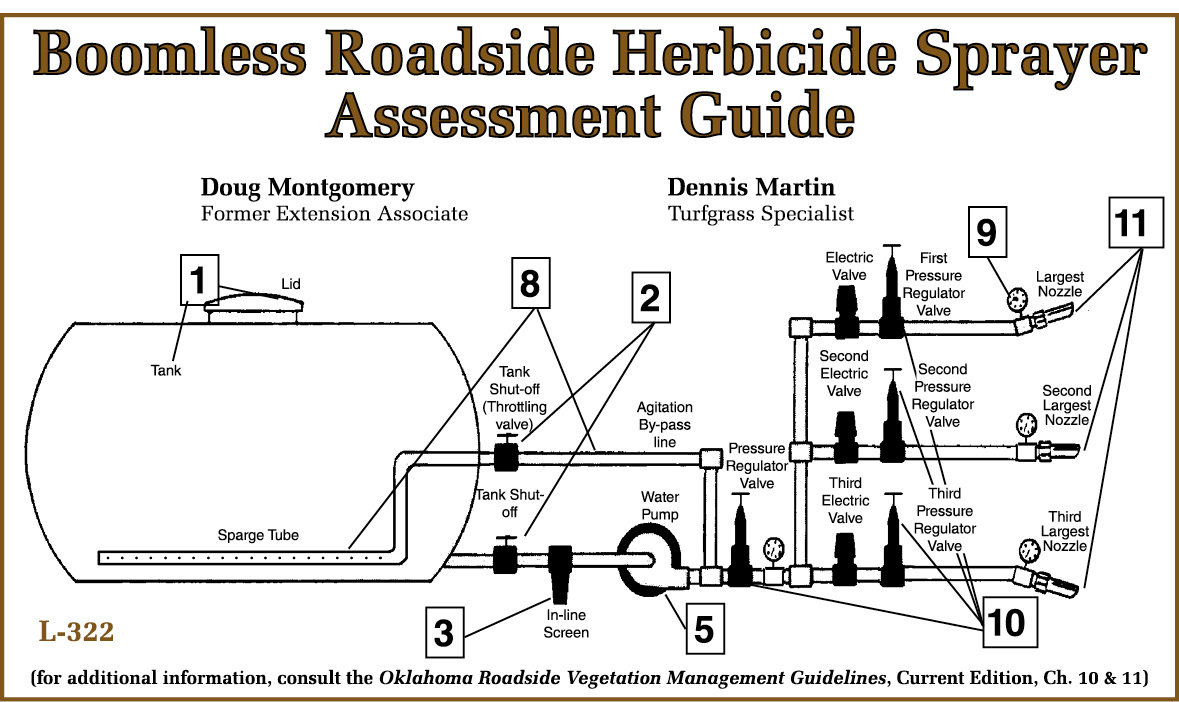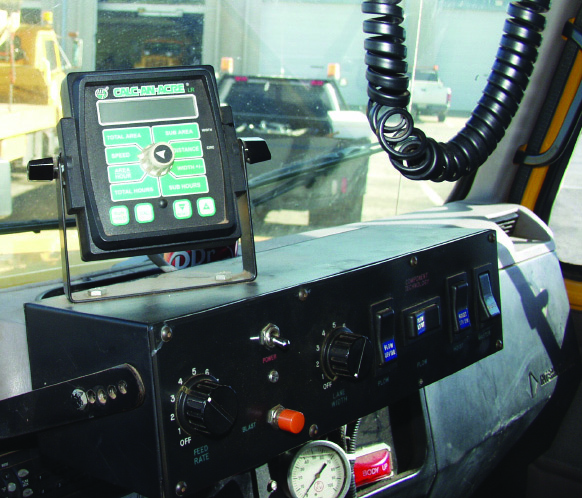Herbicide Guide
- Jump To:
- Troubleshooting Guide
Importance of the Components
1. Tank/lid/vent
Sprayer tank holds the herbicide/water mixture and must be constructed with a material that is resistant to potential corrosion from certain herbicide formulations. There should be no leaks of tank contents anywhere.
The lid should form a watertight seal when closed to avoid spills. A vent hole or
vented lid should be present to prevent the formation of a vacuum in the tank.
2. Tank Shut-off Valve
A tank shut-off valve is required to isolate the tank contents (herbicide and carrier) from the rest of the spray system. This valve allows removal or repair of spray rig components without loss of tank contents or undo exposure of applicators to herbicides during repairs of the sprayer. Valves may be gate valves or ball valves.
3. In-line Screen
Herbicide spray mixture needs to be filtered properly with the use of screens. Screens protect the working parts of the spraying system and help prevent nozzle tip(s) from clogging. For centrifugal pumps, an in-line screen no smaller than 30-mesh is recommended. Finer meshed screens can become clogged with drift control additives and should be avoided at this location. The screen should be placed on the suction side of the pump between the pump and the tank shut-off valve. It should be cleaned frequently (daily).
4. Drift Control Injector
This is an “add on” piece of equipment. It functions to introduce liquid drift control into the suction side of the pump through a drop tube into or just behind the pump. A washer with a 3/16-inch hole centered in the washer, ground to fit inside a ball valve (with the ball valve fully open), allows the proper amount of drift control flow into the suction side of the pump. Water flow back up into the system can cause drift control products to thicken and should be avoided. If drift control injectors are used, they should be plumbed between the in-line screen and the water pump.
5. Water Pump
The heart of the sprayer system is the pump. It must deliver the necessary flow to the nozzle(s) at the desired pressure to ensure proper application. It is recommended that pump flow capacity should be 20 percent greater than the largest flow rate required by the nozzle(s) and hydraulic agitation to compensate for pump wear. The inability to maintain constant or consistent spray pressure may indicate a deteriorated pump. The single stage centrifugal pump is the most popular type pump for low-pressure roadside sprayers.
6. Pump Motor
Pump motors can be hydraulic or gasoline “pony” motors. Hydraulic motors are more applicable to flat terrain and are tied to the truck motor’s RPM (as truck RPM increases or decreases, hydraulic motor RPM may fall or increase. “On demand” hydraulic pump/motors do not do this.). “Pony” gasoline motors are independent of the truck motor and truck motor RPM. “Pony” motors are favored when spraying hilly terrain. Either motor should run smoothly without wide swings in motor RPM to ensure proper application rates.
7. Hoses/Plumbing
The use of synthetic rubber or plastic hoses (high pressure types) having a burst strength greater than the peak operating pressure of the sprayer system are recommended. The use of any other type hose, such as garden hose, is discouraged. Hoses or sprayer lines must be properly sized for the system, flexible, durable, and be resistant to oils and solvents in herbicide formulations. They must also be resistant to weather (i.e. sunlight, ozone, etc.) and general abuse such as twisting, pulling, shock load, or “hydraulic hammer” effects and vibration. If cracks or aging are evident, components should be replaced.
8. Agitation System
An agitator or agitation system is required to mix the components of the spray mixture uniformly and keep them mixed. Some herbicide formulations such as emulsions, wettable powders, liquid, or dry flowables require constant agitation. Constant agitation is needed to keep these herbicide formulations in suspension or they may separate or settle out within the sprayer tanks. Non-functioning/broken agitators should be fixed. Tank length sparge tubes are preferred.
9. Pressure Gauges
Pressure gauges are an integral part of every spray system to correctly indicate an accurate pressure at the nozzle tip(s). A liquid filled pressure gauge, with a maximum reading of 100 psi, is recommended for use on spray rigs and should be mounted as close to the nozzle tip(s) as possible. This provides a more accurate pressure reading during the spraying operation and during the calibration process. Gauges should be visible to operators in the cab to monitor application pressure consistency (a second gauge is necessary if nozzle(s) is rear mounted). Replace all non-functioning gauges.
10. Pressure Regulators
Pressure regulators control the output pressure of spray nozzles. Pressure regulators are used most often when multiple nozzles are used. Single nozzle spray rigs may not have a true “pressure regulator.” Instead, they may have an agitation-line throttling valve that controls the amount of bypass returning to the tank. Individual pressure regulators should operate within a selected pressure range without being screwed all the way in or out. If pressure regulators are not adjustable they should be disassembled, cleaned, and tested. Replace if nonfunctional or broken.
11. Spray Nozzles
Nozzle type determines the uniformity and volume of the spray mixture applied, the completeness of coverage, and the amount of drift. Stainless steel or hardened stainless steel tips are recommended because they are non-corrosive and resistant to abrasion. Boom buster tips produce a more uniform droplet size (fewer fine droplets). When ordering right-of-way nozzles, the letter “R” needs to be added to the specific nozzle model number. Tips with cracked diffusers (nylon tip insert) should be replaced and returned for refurbishing.
12. Control Arms
Control arms are usually electronically controlled rams that adjust the angle of spray nozzles so they can follow the contour of “fill slopes” or “cut slopes.” Initial tip angles should be set with the control arm in the level, or horizontal, position. Proper functioning allows spray pattern width adjustment as slopes are encountered. Improper width adjustment can result in over- or under-application of spray mixtures. All control arms should respond to controls operated by applicators or they should be checked/replaced.
13. Nozzle Shut-off valve(s)
Nozzle shut-off valves are usually activated by an electric solenoid or ball valve that is operated remotely by the applicator. This valve is mounted on the output or discharge line near the nozzle tip(s) to turn the nozzles on or off. It is imperative that this valve be operating properly (not leaking) to avoid misapplication on rights-of-way near sensitive areas. If non-functioning, they should be fixed or replaced.
14. In-cab Switches
Switches turn spray solenoids on and off, activate control arms, and can control hydraulic motor speeds. All should function properly every time they are turned on or off. If the switch does not function properly every time, replace or repair it.
15. Handgun & Hoses
Handguns are used to make spot applications with high carrier rates (50 to 250 GPA, carrier rate is found on the herbicide label). Handguns should turn on and off consistently with no leakage. Hoses should be made of pressure rated materials resistant to bursting. Hoses should be checked regularly for cracks or aging and replaced before hose failure.
16. Calc-An-Acre
This instrument is a digital speed monitoring device that, when properly calibrated, allows a very precise (to the nearest 0.1 MPH) measurement of the ground speed of the sprayer. These devices help provide for consistent and accurate applications. Calibration instructions are included with the device when purchased. Each spray rig should be equipped with a properly working unit to simplify speed adjustment necessary to maintain consistent herbicide application rates (Roadside Vegetation Management Guidelines, Current Edition, Ch. 11).
Troubleshooting Guide
- No delivery of spray liquid through the nozzles.
Check for:- Empty tank.
- Clogged lines, screens, or nozzle tips.
- Sharp kinks in hoses.
- Tank vent closed.
- Improper or poor mixing of herbicide(s).
- Pump failure.
- Pressure regulator failure (if one is used).
- Fluctuating pressure.
Check for:- Material in supply tank is low.
- Dirty screens.
- Trash in the seat of the pressure regulator (if one is used).
- Pump drive slipping (if using auxiliary engine).
- Trash in pump.
- Hydraulic fluid too hot and not adequately cooled (if using hydraulic fluid driven
centrifugal pumps).
- Excessive abrasive action in the pump.
Check for:- Sand, grit, dirt, or crystals.
- Failure to use suction screen.
- Poor agitation of chemicals or mixtures containing solids.
- Starved pump.
Check for:- Shut-off valve to pump is closed.
- Too small of a suction hose or pipe.
- Leaks in suction line.
- Collapse in suction hose.
- Kinks in suction hose.
- Too long of suction line.
- Too high suction line lift.
- Stopped up in-line screen.
- Worn pump.
- Dry pump (no flow or liquid in pump).
Check for:- Running pump too long without liquid.
- Running pump too long while trying to prime the pump.
- Points mentioned in number 4 above.

















